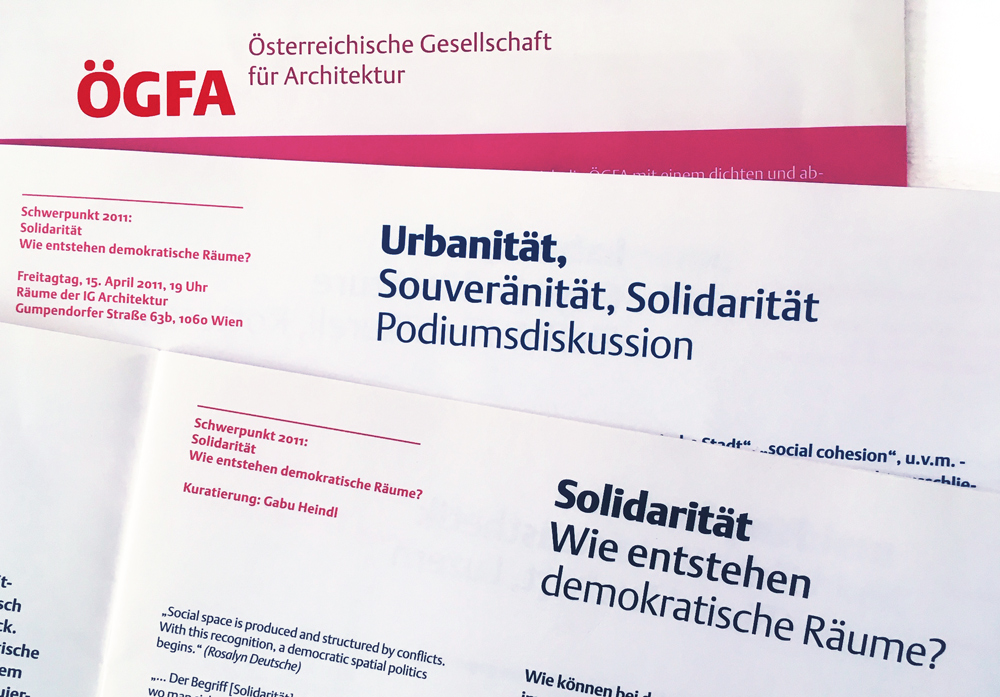Solidarity. How do democratic spaces come into existence?

At present, architectural production seems to consist largely of acquisitions, participation in competitions, advertising measures, defence strategies against fee dumping, questioning of chamber structures, etc. Concerns and time constraints, such as those arising from competitive pressure, the need for flexibility and career imperatives, often leave little time for conceptual, reflective fundamental questions such as what we actually do and build, how, where, for whom or why?
With the annual discourse programme “Solidarity” we do not want to address “ourselves” or the working conditions of architecture, we do not want to make politics of interest, but to be in solidarity with those who differ from us: That means something quite opposed to “putting the users more in the centre”; because often those with whom architecture should be in solidarity are not visible at all as users (but also not as planners) or have no voice.
In addition to the forms of critique that accuse modernity of dogmatizing efficiency and functionality at the expense of the complexity of architecture, we are now also familiar with the critique of the unecological aspects of a standardizing rationality of modern building. If, however, resource scarcity seems to make it necessary to set priorities, then these cannot go exclusively in the direction of energy (savings) and thus a “new efficiency” unquestioned in the current architectural discussion. Rather, the question of new possibilities of a democratic spatial policy is needed, which will also and especially become visible in and out of the crisis.
The oegfa Annual Programme 2011 places solidarity with others in the foreground, even if this can mean de-solidarisation with one’s own: with the role intended for us and the fields of activity accepted by us, with projects described above and seemingly unchangeable injustices. And from the outset, possible problems and “traps” are emerging in this emphasis on solidary architecture: such as the danger of falling into a paternalistic, “caring” act of care for others, or the confusion of architecture with social work – the latter a self-misunderstanding that has to be countered by intensive questions about the forms and aesthetics of solidary architecture.
Text: Gabu Heindl, Austrian Society for Architecture
Curated Programme
Oliver Marchart – Für eine neue Heteronomieästhetik
Vortrag
Fr, 14.01.2011, 19:00 Uhr
Natalie Jeremijenko – On engineering biodiversity, improving environmental health and wrestling Rhinocerous Beetles
Vortrag
Fr, 21.01.2011, 19:00 Uhr
Jesko Fezer – Entwurfsproblem soziale Wirklichkeit
Vortrag
Fr, 11.03.2011, 19:00 Uhr
Wer bestimmt hier? Teilhabe-Projekte in Architektur und Städtebau
Diskussion
Fr, 25.03.2011, 19:00 Uhr
Urbanität, Souveränität, Solidarität
Diskussion
Fr, 15.04.2011, 19:00 Uhr
Pier Vittorio Aureli – Labour, City, Architecture
Vortrag
Fr, 06.05.2011, 19:00 Uhr
Manuel Herz – Flüchtlingslager der West-Sahara
Vortrag
Fr, 27.05.2011, 19:00 Uhr
STALKER – Primaveraromana; Walking for a U Turn. Common design practices for social change
Vortrag
Fr, 17.06.2011, 19:00 Uhr
Arno Brandlhuber – Standardfragen
Vortrag
Fr, 30.09.2011, 19:00 Uhr
Schule machen!
Impulsvorträge und Diskussion
Fr, 04.11.2011, 19:00 Uhr
Margit Mayer – Recht auf Stadt ohne Armut
Vortrag
Fr, 25.11.2011, 19:00 Uhr
Roemer van Toorn – Towards a practice of dissensus Abecedarium of theoretical reflections and projects
Vortrag
Fr, 02.12.2011, 19:00 Uhr
Azra Akšamija – National purification through religious architecture
Vortrag
Fr, 20.01.2012, 19:00 Uhr
Irina Vellay – Solidarische Ökonomie reloaded?
Vortrag
Fr, 23.03.2012, 19:00 Uhr
Wer plant hier? Methodencheck: Demokratie und Stadtplanung
Vortrag
Fr, 30.03.2012, 19:00 Uhr
Susan S. Fainstein – Spatial Justice
Vortrag und Diskussion
Do, 11.10.2012, 19:00 Uhr